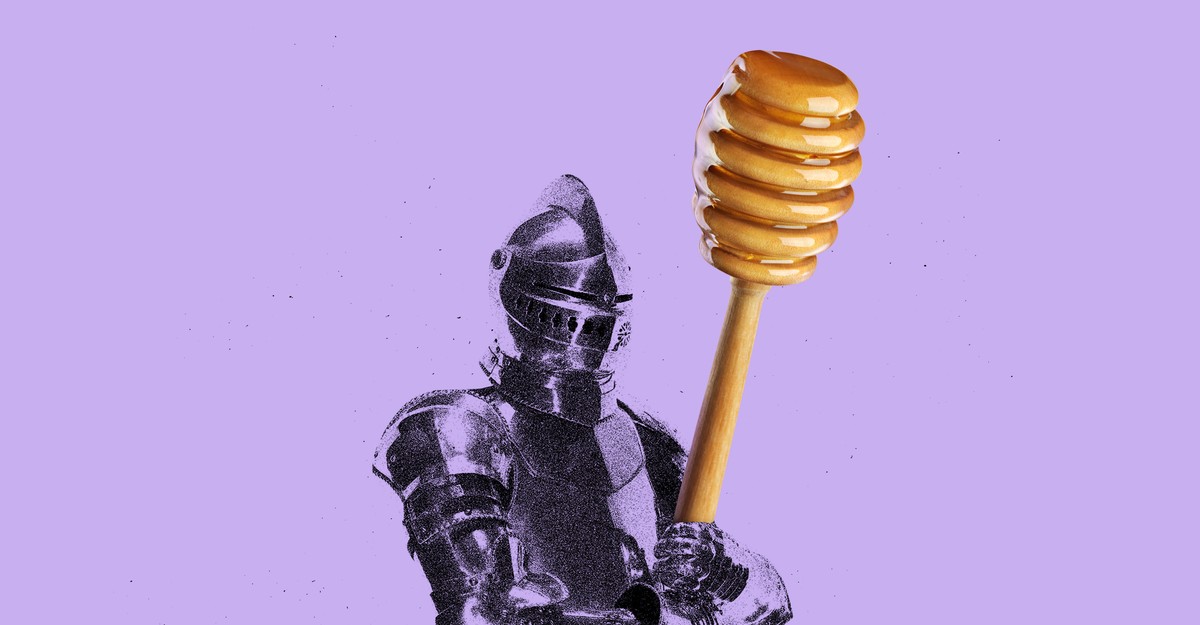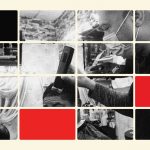When it comes to treating disease with food, the quackery stretches back far. Through the centuries, raw garlic has been touted as a home treatment for everything from chlamydia to the common cold; Renaissance remedies for the plague included figs soaked in hyssop oil. During the 1918 flu pandemic, Americans wolfed down onions or chugged “fluid beef” gravy to keep the deadly virus at bay.
Even in modern times, the internet abounds with dubious culinary cure-alls: apple-cider vinegar for gonorrhea; orange juice for malaria; mint, milk, and pineapple for tuberculosis. It all has a way of making real science sound like garbage. Research on nutrition and immunity “has been ruined a bit by all the writing out there on Eat this to cure cancer,” Lydia Lynch, an immunologist and a cancer biologist at Harvard, told me.
In recent years, though, plenty of legit studies have confirmed that our diets really can affect our ability to fight off invaders—down to the fine-scale functioning of individual immune cells. Those studies belong to a new subfield of immunology sometimes referred to as immunometabolism. Researchers are still a long way off from being able to confidently recommend specific foods or dietary supplements for colds, flus, STIs, and other infectious illnesses. But someday, knowledge of how nutrients fuel the fight against disease could influence the way that infections are treated in hospitals, in clinics, and maybe at home—not just with antimicrobials and steroids but with dietary supplements, metabolic drugs, or whole foods.
Although major breakthroughs in immunometabolism are just now arriving, the concepts that underlie them have been around for at least as long as the quackery. People have known for millennia that in the hours after we fall ill, our appetite dwindles; our body feels heavy and sluggish; we lose our thirst drive. In the 1980s, the veterinarian Benjamin Hart argued that those changes were a package deal—just some of many sickness behaviors, as he called them, that are evolutionarily hardwired into all sorts of creatures. The goal, Hart told me recently, is to “help the animal stay in one place and conserve energy”—especially as the body devotes a large proportion of its limited resources to igniting microbe-fighting fevers.
The notion of illness-induced anorexia (not to be confused with the eating disorder anorexia nervosa) might seem, at first, like “a bit of a paradox,” says Zuri Sullivan, an immunologist at Harvard. Fighting pathogenic microbes is energetically costly—which makes eating less a very counterintuitive choice. But researchers have long posited that cutting down on calories could serve a strategic purpose: to deprive certain pathogens of essential nutrients. (Because viruses do not eat to acquire energy, this notion is limited to cell-based organisms such as bacteria, fungi, and parasites.) A team led by Miguel Soares, an immunologist at the Instituto Gulbenkian de Ciência, in Portugal, recently showed that this exact scenario might be playing out with malaria. As the parasites burst out of the red blood cells where they replicate, the resulting spray of heme (an oxygen-transporting molecule) prompts the liver to stop making glucose. The halt seems to deprive the parasites of nutrition, weakening them and tempering the infection’s worst effects.
Cutting down on sugar can be a dangerous race to the bottom: Animals that forgo food while they’re sick are trying to starve out an invader before they themselves run out of energy. Let the glucose boycott stretch on too long, and the dieter might develop dangerously low blood sugar —a common complication of severe malaria—which can turn deadly if untreated. At the same time, though, a paucity of glucose might have beneficial effects on individual tissues and cells during certain immune fights. For example, low-carbohydrate, high-fat ketogenic diets seem to enhance the protective powers of certain types of immune cells in mice, making it tougher for particular pathogens to infiltrate airway tissue.
Those findings are still far from potential human applications. But Andrew Wang, an immunologist and a rheumatologist at Yale, hopes that this sort of research could someday yield better clinical treatments for sepsis, an often fatal condition in which an infection spreads throughout the body, infiltrating the blood. “It’s still not understood exactly what you’re supposed to feed folks with sepsis,” Wang told me. He and his former mentor at Yale, Ruslan Medzhitov, are now running a clinical trial to see whether shifting the balance of carbohydrates and lipids in their diet speeds recovery for people ill with sepsis. If the team is able to suss out clear patterns, doctors might eventually be able to flip the body’s metabolic switches with carefully timed doses of drugs, giving immune cells a bigger edge against their enemies.
But the rules of these food-illness interactions, to the extent that anyone understands them, are devilishly complex. Sepsis can be caused by a whole slew of different pathogens. And context really, really matters. In 2016, Wang, Medzhitov, and their colleagues discovered that feeding mice glucose during infections created starkly different effects depending on the nature of the pathogen driving disease. When the mice were pumped full of glucose while infected with the bacterium Listeria, all of them died—whereas about half of the rodents that were allowed to give in to their infection-induced anorexia lived. Meanwhile, the same sugary menu increased survival rates for mice with the flu.
In this case, the difference doesn’t seem to boil down to what the microbe was eating. Instead, the mice’s diet changed the nature of the immune response they were able to marshal—and how much collateral damage that response was able to inflict on the body, as James Hamblin wrote for The Atlantic at the time. The type of inflammation that mice ignited against Listeria, the team found, could imperil fragile brain cells when the rodents were well fed. But when the mice went off sugar, their starved livers started producing an alternate fuel source called ketone bodies—the same compounds people make when on a ketogenic diet—that helped steel their neurons. Even as the mice fought off their bacterial infections, their brain stayed resilient to the inflammatory burn. The opposite played out when the researchers subbed in influenza, a virus that sparks a different type of inflammation: Glucose pushed brain cells into better shielding themselves against the immune system’s fiery response.
There’s not yet one unifying principle to explain these differences. But they are a reminder of an underappreciated aspect of immunity. Surviving disease, after all, isn’t just about purging a pathogen from the body; our tissues also have to guard themselves from shrapnel as immune cells and microbes wage all-out war. It’s now becoming clear, Soares told me, that “metabolic reprogramming is a big component of that protection.” The tactics that thwart a bacterium like Listeria might not also shield us from a virus, a parasite, or a fungus; they may not be ideal during peacetime. Which means our bodies must constantly toggle between metabolic states.
In the same way that the types of infections likely matter, so do the specific types of nutrients: animal fats, plant fats, starches, simple sugars, proteins. Like glucose, fats can be boons in some contexts but detrimental in others, as Lynch has found. In people with obesity or other metabolic conditions, immune cells appear to reconfigure themselves to rely more heavily on fats as they perform their day-to-day functions. They can also be more sluggish when they attack. That’s the case for a class of cells called natural killers: “They still recognize cancer or a virally infected cell and go to it as something that needs to be killed,” Lynch told me. “But they lack the energy to actually kill it.” Timing, too, almost certainly has an effect. The immune defenses that help someone expunge a virus in the first few days of an infection might not be the ones that are ideal later on in the course of disease.
Even starving out bacterial enemies isn’t a surefire strategy. A few years ago, Janelle Ayres, an immunologist at the Salk Institute for Biological Studies, and her colleagues found that when they infected mice with Salmonella and didn’t allow the rodents to eat, the hungry microbes in their guts began to spread outside of the intestines, likely in search of food. The migration ended up killing tons of their tiny mammal hosts. Mice that ate normally, meanwhile, fared far better—though the Salmonella inside of them also had an easier time transmitting to new hosts. The microbes, too, were responding to the metabolic milieu, and trying to adapt. “It would be great if it was as simple as ‘If you have a bacterial infection, reduce glucose,’” Ayres said. “But I think we just don’t know.”
All of this leaves immunometabolism in a somewhat chaotic state. “We don’t have simple recommendations” on how to eat your way to better immunity, Medzhitov told me. And any that eventually emerge will likely have to be tempered by caveats: Factors such as age, sex, infection and vaccination history, underlying medical conditions, and more can all alter people’s immunometabolic needs. After Medzhitov’s 2016 study on glucose and viral infections was published, he recalls being dismayed by a piece from a foreign outlet circulating online claiming that “a scientist from the USA says that during flu, you should eat candy,” he told me with a sigh. “That was bad.”
But considering how chaotic, individualistic, and messy nutrition is for humans, it shouldn’t be a surprise that the dietary principles governing our individual cells can get pretty complicated too. For now, Medzhitov said, we may be able to follow our instincts. Our bodies, after all, have been navigating this mess for millennia, and have probably picked up some sense of what they need along the way. It may not be a coincidence that during viral infections, “something sweet like honey and tea can really feel good,” Medzhitov said. There may even be some immunological value in downing the sick-day classic, chicken soup: It’s chock-full of fluid and salts, helpful things to ingest when the body’s electrolyte balance has been thrown out of whack by disease.
The science around sickness cravings is far from settled. Still, Sullivan, who trained with Medzhitov, jokes that she now feels better about indulging in Talenti mango sorbet when she’s feeling under the weather with something viral, thanks to her colleagues’ 2016 finds. Maybe the sugar helps her body battle the virus without harming itself; then again, maybe not. For now, she figures it can’t hurt to dig in.






